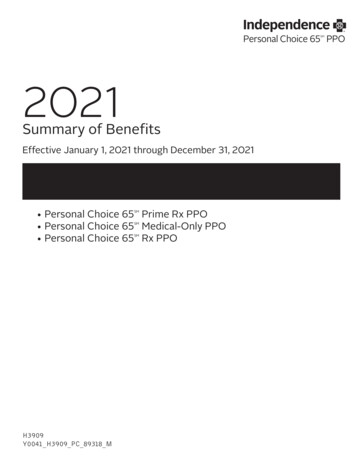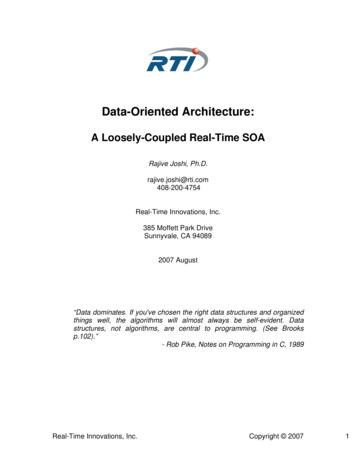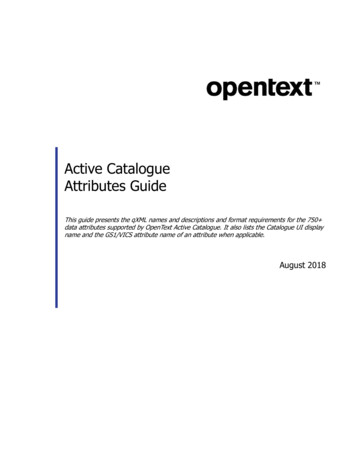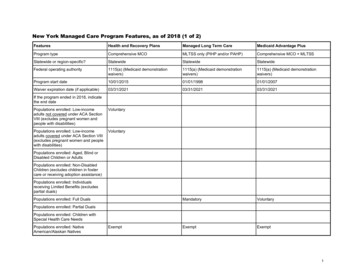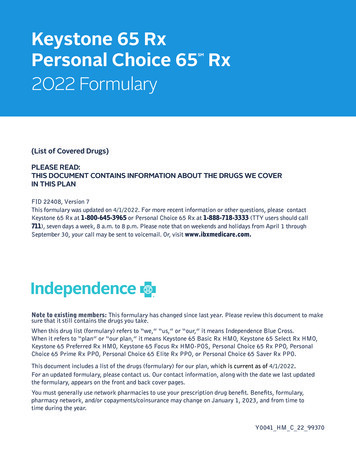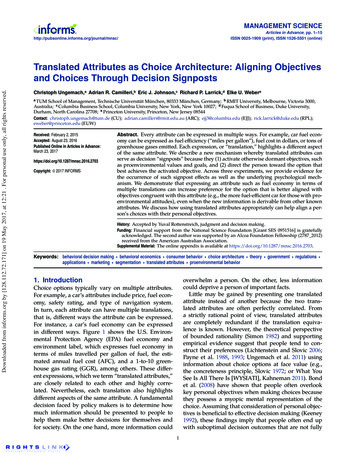
Transcription
MANAGEMENT SCIENCEArticles in Advance, pp. 1–15ISSN 0025-1909 (print), ISSN 1526-5501 /Downloaded from informs.org by [128.112.72.171] on 19 May 2017, at 12:21 . For personal use only, all rights reserved.Translated Attributes as Choice Architecture: Aligning Objectivesand Choices Through Decision SignpostsChristoph Ungemach,a Adrian R. Camilleri,b Eric J. Johnson,c Richard P. Larrick,d Elke U. Weberea TUM School of Management, Technische Universität München, 80333 München, Germany; b RMIT University, Melbourne, Victoria 3000,Australia; c Columbia Business School, Columbia University, New York, New York 10027; d Fuqua School of Business, Duke University,Durham, North Carolina 27708; e Princeton University, Princeton, New Jersey 08544Contact: christoph.ungemach@tum.de (CU); adrian.camilleri@rmit.edu.au (ARC); ejj3@columbia.edu (EJJ); rick.larrick@duke.edu (RPL);eweber@princeton.edu (EUW)Received: February 2, 2015Accepted: August 23, 2016Published Online in Articles in Advance:March 23, t: 2017 INFORMSAbstract. Every attribute can be expressed in multiple ways. For example, car fuel econ-omy can be expressed as fuel efficiency (“miles per gallon”), fuel cost in dollars, or tons ofgreenhouse gases emitted. Each expression, or “translation,” highlights a different aspectof the same attribute. We describe a new mechanism whereby translated attributes canserve as decision “signposts” because they (1) activate otherwise dormant objectives, suchas proenvironmental values and goals, and (2) direct the person toward the option thatbest achieves the activated objective. Across three experiments, we provide evidence forthe occurrence of such signpost effects as well as the underlying psychological mechanism. We demonstrate that expressing an attribute such as fuel economy in terms ofmultiple translations can increase preference for the option that is better aligned withobjectives congruent with this attribute (e.g., the more fuel-efficient car for those with proenvironmental attitudes), even when the new information is derivable from other knownattributes. We discuss how using translated attributes appropriately can help align a person’s choices with their personal objectives.History: Accepted by Yuval Rottenstreich, judgment and decision making.Funding: Financial support from the National Science Foundation [Grant SES 0951516] is gratefullyacknowledged. The second author was supported by an Alcoa Foundation Fellowship (2787 2012)received from the American Australian Association.Supplemental Material: The online appendix is available at https://doi.org/10.1287/mnsc.2016.2703.Keywords: behavioral decision making behavioral economics consumer behavior choice architecture theory government regulations applications marketing segmentation translated attributes proenvironmental behavior1. Introductionoverwhelm a person. On the other, less informationcould deprive a person of important facts.Little may be gained by presenting one translatedattribute instead of another because the two translated attributes are often perfectly correlated. Froma strictly rational point of view, translated attributesare completely redundant if the translation equivalence is known. However, the theoretical perspectiveof bounded rationality (Simon 1982) and supportingempirical evidence suggest that people tend to construct their preferences (Lichtenstein and Slovic 2006;Payne et al. 1988, 1993; Ungemach et al. 2011) usinginformation about choice options at face value (e.g.,the concreteness principle, Slovic 1972; or What YouSee Is All There Is [WYSIATI], Kahneman 2011). Bondet al. (2008) have shown that people often overlookkey personal objectives when making choices becausethey possess a myopic mental representation of thechoice. Assuming that consideration of personal objectives is beneficial to effective decision making (Keeney1992), these findings imply that people often end upwith suboptimal decision outcomes that are not fullyChoice options typically vary on multiple attributes.For example, a car’s attributes include price, fuel economy, safety rating, and type of navigation system.In turn, each attribute can have multiple translations,that is, different ways the attribute can be expressed.For instance, a car’s fuel economy can be expressedin different ways. Figure 1 shows the U.S. Environmental Protection Agency (EPA) fuel economy andenvironment label, which expresses fuel economy interms of miles travelled per gallon of fuel, the estimated annual fuel cost (AFC), and a 1-to-10 greenhouse gas rating (GGR), among others. These different expressions, which we term “translated attributes,”are closely related to each other and highly correlated. Nevertheless, each translation also highlightsdifferent aspects of the same attribute. A fundamentaldecision faced by policy makers is to determine howmuch information should be presented to people tohelp them make better decisions for themselves andfor society. On the one hand, more information could1
2Ungemach et al.: Translated Attributes as Choice ArchitectureManagement Science, Articles in Advance, pp. 1–15, 2017 INFORMSFigure 1. (Color online) The Current U.S. Environmental Protection Agency Fuel Economy and Environment Label forDownloaded from informs.org by [128.112.72.171] on 19 May 2017, at 12:21 . For personal use only, all rights reserved.Gasoline Vehiclesaligned with personal objectives. Bond et al. (2008)have suggested that recognition of important personal objectives may be assisted through guides thatdescribe additional features of products such as consumer reports. We propose that translated attributesplay a similar role in improving choice: they allowpeople to recognize important personal objectives thatwould otherwise be overlooked. Therefore, our general hypothesis is that translated attributes have thepotential to influence preferences because they serveas decision “signposts” helping people first recognizeand then pursue options congruent with their personalobjectives.Previous literature has shown that partitioning aglobal attribute into components can increase theweight accorded to that global attribute (Dawes 1979,Fischhoff et al. 1978, Weber et al. 1988). For example, the global attribute “job security” can be split intocomponent attributes such as “stability of the firm”and “personal job security.” Although related to partitioning, the notion of translated attributes has threefeatures that distinguish it from this earlier literature.First, translated attributes are monotone transformations of each other and highly correlated, whereas components of a global attribute described in the attributesplitting literature may not be correlated at all. Second, translated attributes differ from derived attributesused in advertising, such as a car being described as“masculine,” because translated attributes all map ontoactual physical properties of the object. Third, andmost importantly, whereas the attribute splitting literature demonstrates the phenomenon that the sumof component attributes attracts more weight than theglobal attribute, we identify and test two different processes by which translated attributes affect decisions.Specifically, we distinguish the established effects ofnoncompensatory heuristics such as counting superiority across attributes and using the majority rule (e.g.,Alba and Marmorstein 1987, Russo and Dosher 1983,Zhang et al. 2006), and our own novel explanation:activation of relevant objectives and direction towardachieving them through decision signposts.1.1. Translated Attributes as Decision SignpostsOn a roadside, a signpost has two important features: First, it indicates the presence of a destinationthat might be of personal relevance, such as a nearbytown. Second, it points out how to reach the destination by providing the actual direction and distanceto travel. Similarly, translated attributes possess bothfeatures. First, translated attributes can produce activation of personally relevant objectives. This impliesthat a translated attribute will have the most impacton those who have objectives matching those aspectshighlighted by the translated attribute. Second, a decision signpost conveys direction toward achieving thoseobjectives by explicitly describing the degree to whichdifferent options meet the person’s objectives.People have many objectives that can arise from different sources, such as values and goals. Values arestable dispositions that structure and guide specificbeliefs, norms, and attitudes (Feather 1995, Rokeach1973). Goals are motivational constructs directed toachieve a desirable end state (van Osselaer andJaniszewski 2012). Goals direct movement that leads todegrees of achievement allowing progress (and failure)
Ungemach et al.: Translated Attributes as Choice Architecture3Downloaded from informs.org by [128.112.72.171] on 19 May 2017, at 12:21 . For personal use only, all rights reserved.Management Science, Articles in Advance, pp. 1–15, 2017 INFORMSto be gauged (Huang et al. 2012). Goals, such as loosing 5 lbs over the summer, are typically more specificand temporary than values, such as living healthily.Values can direct which goals are considered important, and prioritized objectives can direct attention tocongruent information, which in turn affects behavior (Stern and Dietz 1994). However, Bond et al. (2008)demonstrate that people often focus too narrowly andforget many objectives that they consider to be valuable, unless aided.We argue that our proposed signpost effect is conceptually distinct from previous work on framingand priming. Traditional “framing effects” occur whenbehavior changes in response to different representations of information that is equivalent in basic structure and final consequences. For example, Levin et al.(1998) distinguish three types of framing effects, eachrelying on different cognitive mechanisms: risky choiceframing, attribute framing, and goal framing. Each ofthese framing categories relies on changes in valance:risky choice framing contrasts options in terms of gainand loss; attribute framing contrasts object characteristics positively and negatively; goal framing contrastspositive consequences of engaging in a behavior withnegative consequences of not engaging in the behavior.Our proposed translated attribute effect is distinct fromthese framing effects because it does not rely on such“valence shifts.” Indeed, we would expect the sameactivation-and-direction effect regardless of positive ornegative valence.Finally, we argue that the effect of signposts is distinct from “bottom-up” priming effects, which findthat a goal (e.g., becoming educated) can be activatedthrough the subliminal presentation of means to complete that goal (e.g., study; Shah and Kruglanski 2003).First, when a translated attribute acts as decision signpost, the objective is directly presented and comprehended. Second, translated attributes, when acting asdecision signposts, also provide directional information about how to choose and act, which primes do not.1.2. Translated Attributes as Choice ArchitectureBecause they act as decision signposts, translated attributes represent a type of choice architecture intervention. Choice architecture refers to the applicationof behavioral insights to understand the influence thatdifferent ways of presenting information about choiceoptions can have on decisions and behavior (Sunstein2011, Thaler and Sunstein 2008, Johnson et al. 2012).Examples of application domains include personalhealth (e.g., Kling et al. 2012), retirement savings (e.g.,O’Donoghue and Rabin 1999), and the environment(e.g., Camilleri and Larrick 2014, Larrick and Soll 2008).Choice architecture builds on insights about the effectof defaults (Johnson and Goldstein 2003), the numberof alternatives presented (Payne et al. 1993), and thepartitioning of options and attributes (Fox et al. 2005;for reviews, see Johnson et al. 2012 and Camilleri andLarrick 2015). These interventions, sometimes referredto as “nudges,” often operate beneath conscious awareness to help improve individual and social welfare(Smith et al. 2013, Thaler and Sunstein 2008). However, this lack of awareness exposes such interventionsto the criticism that they manipulate individuals byrestricting their autonomy to act upon their own preferences (e.g., Hausman and Welsh 2010). As we demonstrate below, the presentation of translated attributescan be an effective and benevolent aspect of choicearchitecture that does not restrict individuals’ autonomy. Instead, it allows people to select options that aremore consistent with their personal objectives. This isalso another important theoretical distinction betweensignposts and counting effects (such as attribute splitting effects and majority rule strategies). Whereas simply steering people to an option that is superior onmultiple positive (translated) attributes is potentially a“trick,” guiding people to see what they care about andto act on this preference is helpful to the individual.In summary, our novel contribution is the idea thatthe presentation of translated attributes can be utilizedselectively as decision signposts to help people matchoptions with their personal objectives. Specifically, wepredict that the effect of shifting preferences throughthe provision of translated attributes will be strongestfor those who have personal objectives congruent withthose highlighted by the translated attributes. Whena translation is distinct enough to activate an overlooked objective, a signpost effect is expected to occurin addition to any simple counting heuristic effects,which are agnostic with regard to the type of translated attributes presented. Finally, we predict this signpost effect to occur only when the presented attributesprovide directional information, allowing the person toidentify options that are aligned with activated personal objectives.The rest of this paper is arranged as follows: In Experiment 1, we demonstrate how translated attributes canaffect preferences dependent on the congruency between the translated attribute and a person’s values.In Experiment 2, we show that signpost effects cannot be explained by differences in perceived knowledgeabout the relation between attributes provided by onetranslated attribute versus another. In Experiment 3, weshow how translated attributes act as decision signpostsby explicitly manipulating the activation and directionfeatures of translated attributes.2. Experiment 1—The Signpost EffectThe purpose of Experiment 1 was to test the value activation mechanism proposed as part of the hypothesized
Ungemach et al.: Translated Attributes as Choice ArchitectureDownloaded from informs.org by [128.112.72.171] on 19 May 2017, at 12:21 . For personal use only, all rights reserved.4Management Science, Articles in Advance, pp. 1–15, 2017 INFORMSsignpost effect. We chose to focus on the environmental domain, specifically choices between cars that differ in terms of their fuel economy, because it providesan acknowledged paradox of consumers appearing toselect options that are not in their economic self-interest(National Highway Traffic Safety Administration 2010).We asked participants to choose between pairs of carswhere the global attributes were price and fuel economy, which were arranged to trade off against oneanother. In line with our proposed translated attributeframework, we used three highly correlated translations for the car fuel economy attribute: annual fuel cost,gallons (of gas consumed) per 100 miles, and greenhouse gas rating. We assumed that annual fuel costwas likely to activate financial objectives, that gallonsper 100 miles was likely to activate fuel consumptionobjectives, and that greenhouse gas rating was likely toactivate preexisting proenvironmental values. This latter assumption was guided by the fact that greenhousegases have been identified as the most significant driverof climate change (IPCC 2013) and the greenhouse effect(U.S. Environmental Protection Agency 2014). In addition, a significant proportion of sustainability-relatedproduct claims are based on carbon emissions (Cohenand Vandenbergh 2012), and consumers are familiarwith its usage. Two advantages of focusing on theactivation of proenvironmental values were that we(a) knew that such values varied in strength acrossthe population and (b) environmental attitude couldbe assessed with a well-validated measure. Participantswere presented either one or two of these translated fueleconomy attributes. Our experimental design kept thetype of translation orthogonal to the number of translated attributes presented, which allowed us to distinguish between the effect of counting heuristics and theproposed signpost mechanism.Based on past research, we predicted that when carswere presented with more translated fuel economyattributes, participants would be more likely to prefer the more fuel-efficient car (Alba and Marmorstein1987, Russo and Dosher 1983, Zhang et al. 2006). Congruent with our signpost effect hypothesis, we furtherpredicted that the effect of translated attributes wouldbe moderated, and be stronger for participants whovalued the environment. Specifically, we predicted thatmore proenvironmental participants would be morelikely to choose the fuel-efficient car when the presented translated attribute was associated with theenvironmental impact of fuel economy (i.e., when presented with greenhouse gas rating). This is because theenvironmental attribute was expected to activate preexisting environmental values and highlight the otherwise overlooked proenvironmental objective in thedecision. However, this moderation was not expectedto occur when the presented translated attribute wasnot associated with the environmental impact of fueleconomy (e.g., annual fuel cost).2.1. Method2.1.1. Participants. Three hundred forty-one Americanparticipants (52% female; mean age 31.8; SD 10.1)were recruited through Amazon’s Mechanical Turk(MTurk) and paid a flat fee for their participation.2.1.2. Materials. Choice Design. We designed a set ofnine choice problems (see Table 1). Cars were describedin terms of price and either one or two different translated attributes of fuel economy. In the cases wherethere was one fuel economy attribute, half the participants were presented with “annual fuel cost” and theother half with “greenhouse gas rating.” In the caseswhere there were two fuel economy attributes, half theparticipants were presented with “annual fuel cost”together with “greenhouse gas rating,” and the otherhalf of participants were presented with “annual fuelcost” together with “gallons per 100 miles” (GPM).Annual fuel cost, greenhouse gas rating, and gallonsper 100 miles were highly correlated. Annual fuel costwas calculated assuming 15,000 miles driven annuallyand 3.70 per gallon of gas (similar assumptions underlie the calculated values presented on the AmericanTable 1. Set of Nine Choice Problems Used in Experiments 1 and 3Car A ( )Choice problem123456789Car B ( )PriceAnnual fuel costaPriceAnnual fuel costaDifference in total costover five years (car A B) ( ,246 1,425 1,954 5,1255,0214,521821 9251,746Notes. The lower price car is always car A. The ordering of the cars during the experiments was counterbalanced.aThe fuel cost assumes 15,000 miles driven annually for five years, costing 3.70 for gas and no discount rate.
Ungemach et al.: Translated Attributes as Choice Architecture5EPA label). Gallons per 100 miles was described as thefuel efficiency of the car in terms of how many gallonsof fuel were required to travel 100 miles. Greenhousegas rating was described as a 1-to-10 rating comparinga car’s fuel economy and tailpipe carbon dioxide (CO2 )emissions to those of all other new cars, where a ratingof 10 was best (i.e., fewest CO2 emissions). The valuesfor the different attribute levels reflected typical rangesencountered in actual car choices in a factorial design.Environmental Values. Environmental values weremeasured with the New Ecological Paradigm–Revised(NEP-R) scale (Dunlap et al. 2000), which is a standardmeasure of attitudes toward sustainability. Participantsrated 15 statements (e.g., “Humans have the right tomodify the natural environment to suit their needs”)on five-point scales ranging from “strongly disagree”to “strongly agree.” Scores on the NEP-R scale rangefrom 15 to 75. Higher scores indicate stronger proenvironmental values.subsequent analysis, leaving 320 participants. However, as described below, all conclusions remain unchanged if we include these data in the analysis.2.1.3. Design. We employed a 2 (number of fuel-effi-portions of fuel-efficient car choices in the four experimental groups collapsed across choice sets. On average, participants chose the fuel-efficient option 54% ofthe time (SD 31%). In line with a counting explanation, participants made more fuel-efficient choiceswhen fuel economy was expressed via two translatedattributes (right pair of bars) than one (left pair of bars).To investigate the signpost effect, we examined therelationship between the observed likelihood of choosing the environmental option across participants’ environmental attitudes as indicated by their NEP-R scores(see Figure 3). As predicted, the probability of choosingciency attributes: 1 vs. 2) 2 (environmental attribute:present vs. absent) 9 (choice set) mixed design. Thefirst two factors were between subjects and the thirdfactor was within subjects. The main dependent variable was whether or not participants selected the fuelefficient car.2.1.4. Procedure. Participants first read an instructionscreen in which they were told to assume they averaged15,000 miles of driving each year and that they wouldkeep the car for five years before giving it away. Participants were also shown a summary of the price andfuel-efficiency attribute definitions they would later bepresented with. During the choice task, participantssaw two options in a table format with price andfuel economy attributes (see Online Appendix A). Thechoice screens also displayed the attribute definitions.Participants made a total of nine choices betweendifferent pairs of cars. After these choices, participantsrated the extent to which they considered the environmental and the cost aspects of the cars, respectively,when making their choices. These responses weremade on five-point scales ranging from “not at all”to “exclusively.” Participants were then asked to judgehow important a number of different car attributes(e.g., price, car type, safety rating, miles per gallon(MPG)) would be to them if making a real car purchase,on five-point scales ranging from “unimportant” to“extremely important.” Finally, participants completeditems relating to demographics, past driving behavior,environmental attitudes (NEP-R scale), and an attention check.2.2. ResultsTwenty-one participants incorrectly answered the attention check question and were removed from the2.2.1. Activation of Environmental Values. To assesswhether our manipulation was successful in activating environmental values, we checked the effect ofpresenting the greenhouse gas rating attribute onthe self-rating of considering the environmental andcost aspects of the cars in participants’ decisions. Asexpected, participants reported considering the environmental aspect to a greater extent when the GGRwas present (mean 2.95, SD 1.12) than when it wasabsent (mean 1.81, SD 1.00, t(312.16) 9.553, p 0.0001). Conversely, in conditions with the GGR rating present, the cost aspect was considered to a lesserextent (mean 3.78, SD 0.85) than in conditions without the GGR rating (mean 4.20, SD 0.75), t(312.94) 4.836, p 0.0001).2.2.2. Preferences. Figure 2 shows the observed pro-Figure 2. Proportion of Choices for the Fuel-EfficientOption in Experiment 1 as a Function of the Number ofFuel-Efficiency Attributes and Whether an EnvironmentalAttribute Was Presented or Not1.00Proportion choosing the fuel-efficient carDownloaded from informs.org by [128.112.72.171] on 19 May 2017, at 12:21 . For personal use only, all rights reserved.Management Science, Articles in Advance, pp. 1–15, 2017 INFORMSEnvironmental attribute:AbsentPresent0.750.500.25012No. of fuel-efficiency attributesNote. Error bars are the standard error of the mean (SEM).
Ungemach et al.: Translated Attributes as Choice Architecture6Management Science, Articles in Advance, pp. 1–15, 2017 INFORMSFigure 3. Probability of Choosing the Fuel-Efficient Car in0ROBABILITY OF CHOOSING THE FUEL EFFICIENT CARDownloaded from informs.org by [128.112.72.171] on 19 May 2017, at 12:21 . For personal use only, all rights reserved.Experiment 1 Modeled as a Function of EnvironmentalValues, Number of Fuel-Efficiency Attributes, and Whetheran Environmental Attribute Was Presented or Not%NVIRONMENTAL ATTRIBUTEABSENT%NVIRONMENTAL ATTRIBUTEPRESENT .O OF FUEL EFFICIENCYATTRIBUTES n n n n n n %NVIRONMENTAL VALUE .%0 2 SCORE CENTEREDthe fuel-efficient car increased with increasing NEP-Rscores when the GGR attribute was present (rightpanel). However, this relationship was not observed inthe conditions without the GGR attribute (left panel).To test that this effect was statistically significant,we compared several nested multilevel logistic regression models with selection of the fuel-efficient car asthe dependent variable. All models contained randomintercepts for participants and choice problems. For themain hypotheses, we included simple fixed effects forthe number of attributes presented, a dummy variableindicating the presence of the GGR attribute, and thetwo-way GGRpresent NEP-R interaction to test the signpost effect. The model confirmed that participants weremore likely to select the fuel-efficient option when fuelefficiency was expressed by two translated attributescompared to one (χ2 (1) 9.16, p 0.01). In addition, and in line with our prediction, the relationshipbetween environmental attitudes and the probabilityof choosing the fuel-efficient car was moderated bythe presence of the GGR attribute, as indicated by asignificant GGRpresent NEP-R interaction (χ2 (1) 12.2,p 0.001).1 Finally, a comparison with a model thatalso included a number of attributes NEP-R interaction showed that the relationship between environmental attitudes and the probability of choosing thefuel-efficient car was not moderated by the number ofattributes presented (i.e., number of attribute NEP-Rinteraction, χ2 (1) 0.62, p 0.05).2.3. DiscussionThe observations made in Experiment 1 illustrate thatboth the number of attributes and the type of attributesindependently influence people’s preferences. First,presenting more translated fuel economy attributes increased the likelihood of choosing the more fuel-efficient car, regardless of the type of attributes. Second,and in line with our hypothesized signpost effect, thepresentation of an environmental translated attributeincreased the likelihood of choosing the more fuelefficient car, regardless of the number of total presentedattributes. Importantly, the increase in fuel-efficientchoices was driven by those with higher proenvironmental values and cannot be explained by a simplecounting heuristic. Rather, it appears that the presence of the environmental translated attribute activated respondents’ preexisting but latent proenvironmental value, and subsequently aligned choices withpersonal values.An alternative explanation for our observations isthat participants may have received different information when presented with one attribute combinationcompared to another. Therefore, the purpose of Experiment 2 was to contrast our activation-and-directionaccount with this potential informational account.3. Experiment 2—Effects of InformationAccording to our value-activation-and-direction account, translated attributes serve as decision-signposts:They activate a person’s preexisting objectives and thenhelp the person to identify which option best alignswith their activated objective. According to the informational account, a person might fail to realize that certain attributes are translations of one another and, as aresult of this oversight, have a different knowledge basewith relation to one attribute combination compared toanother. Moreover, a person might gain different information about the relation between attributes throughout the experiment depending on the experimentalmanipulation they were assigned to. For example, participants presented with a greenhouse gas rating mightfind it easier to learn the relation between environmental impact and annual fuel cost compared to participants presented with gallons per 100 miles and annualfuel cost.To rule out this informational account, we replicatedExperiment 1 while manipulating whether knowledgeabout the relation between translated attributes wasmeasured before versus after the choice task. If theinformational account were true, we would expect thatknowledge regarding the relation between translatedattributes would be different before versus after thechoice task, or as a function of which attributes werepresented during the choice task.3.1. Methods3.1.1. Participants. Seven hundred ninety-nine American participants (44% female; mean age 31; SD 11.2)were recruited through MTurk and paid a flat fee fortheir participation.
Ungemach et al.: Translated Attributes as Choice ArchitectureManagement Science, Articles in Advance, pp. 1–15, 2017 INFORMSDownloaded from informs.org by [128.112.72.171] on 19 May 2017, at 12:21 . For personal use only, all rights reserved
Ungemachetal.: Translated Attributes as Choice Architecture ManagementScience,Articles in Advance,pp.1-15, 2017INFORMS ATTRIBUTES 1
